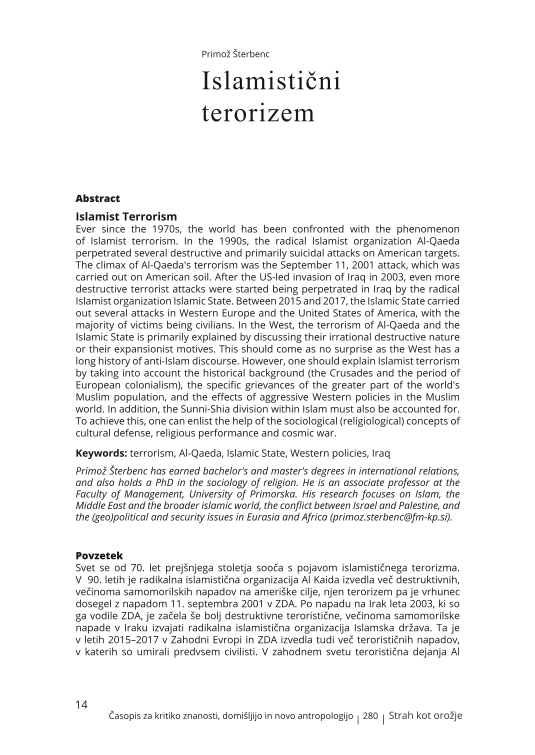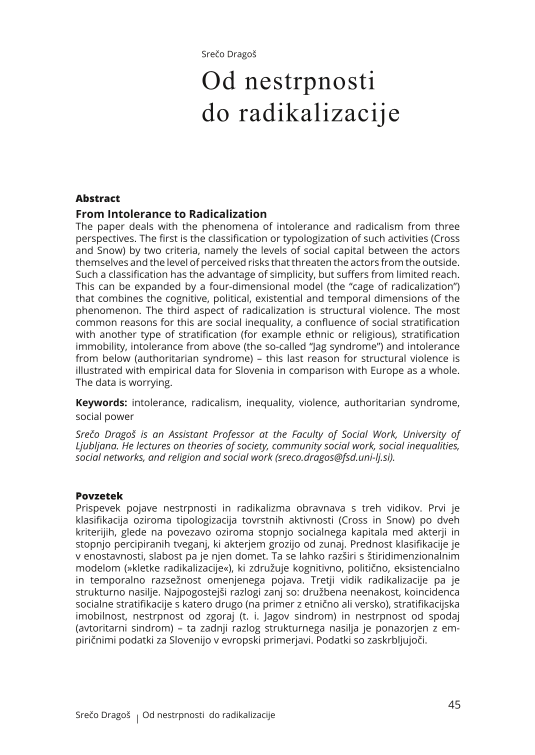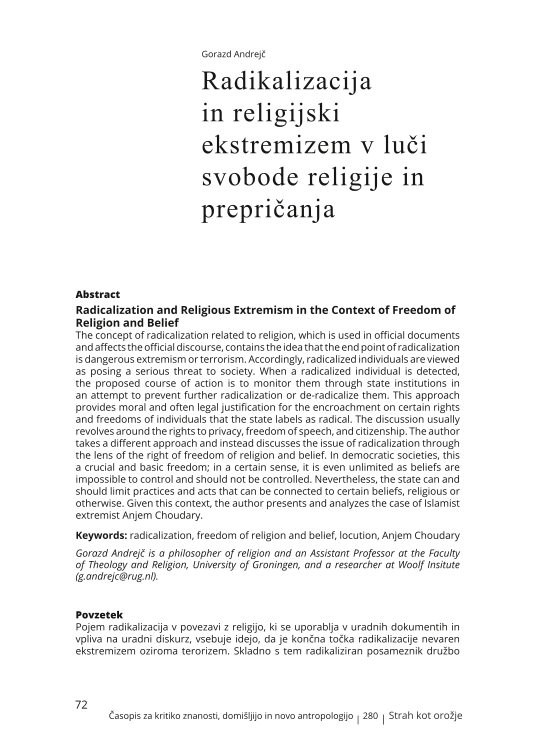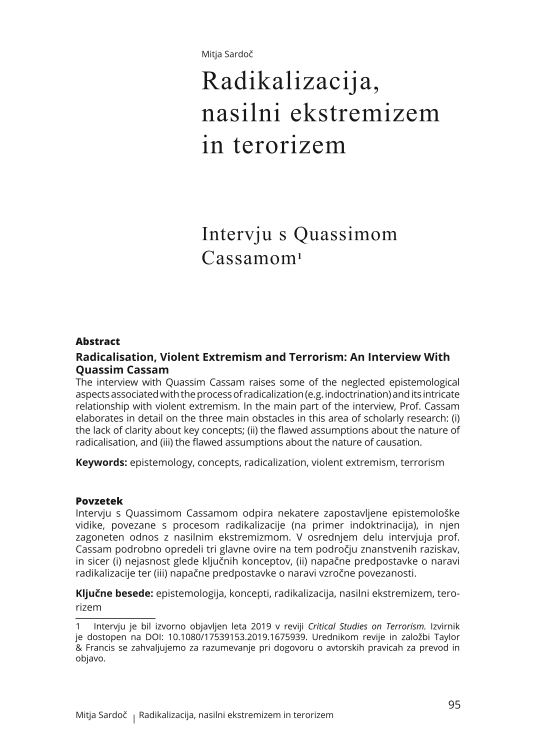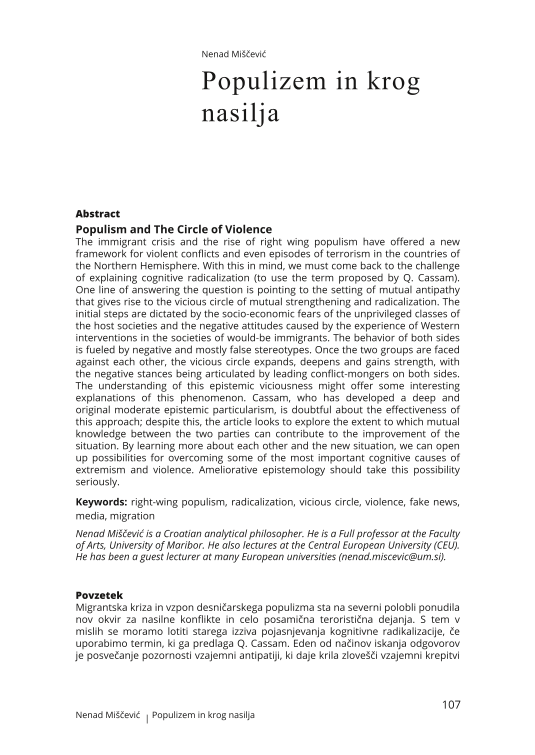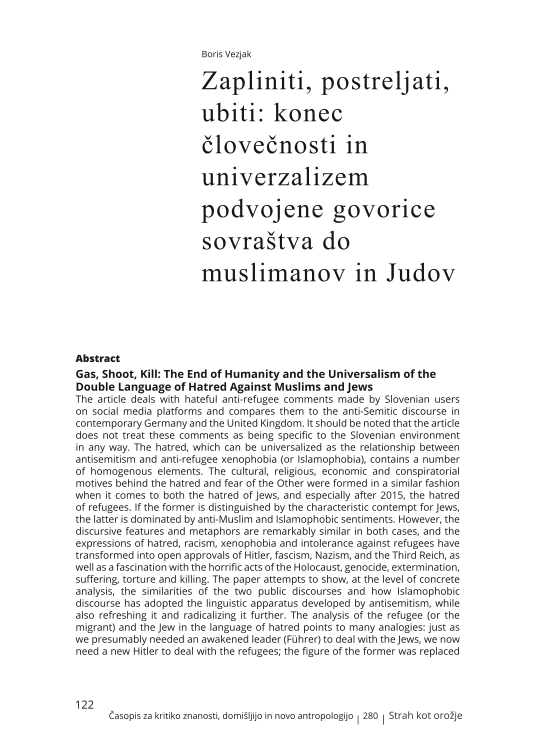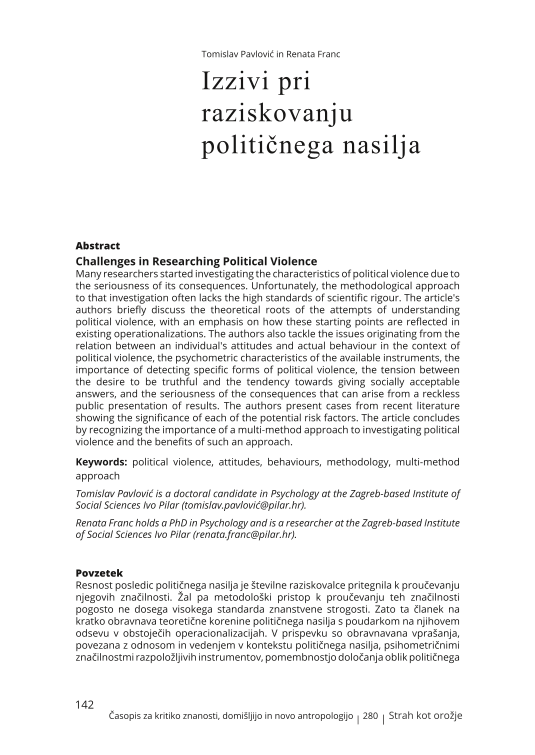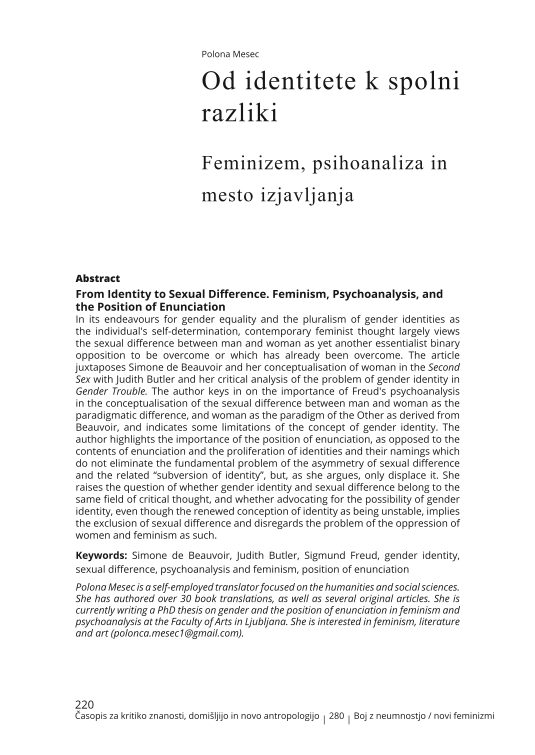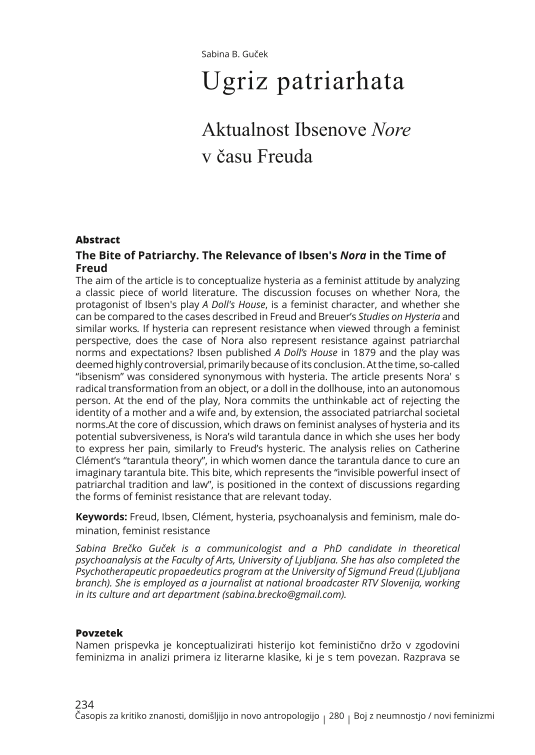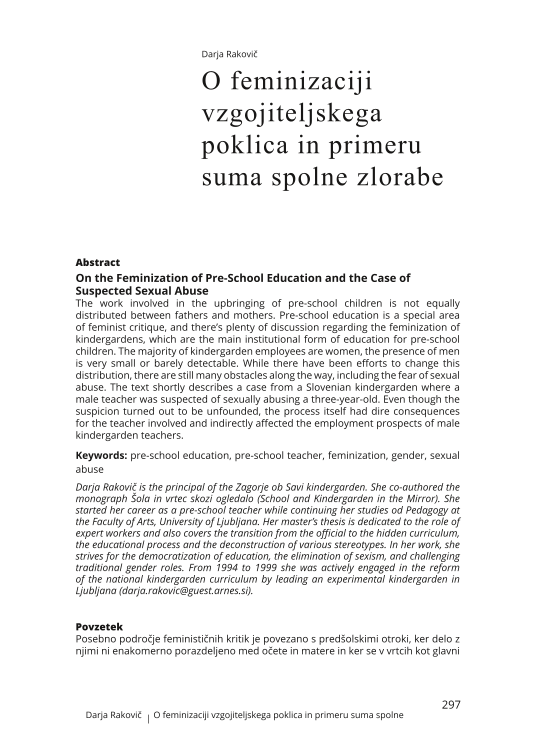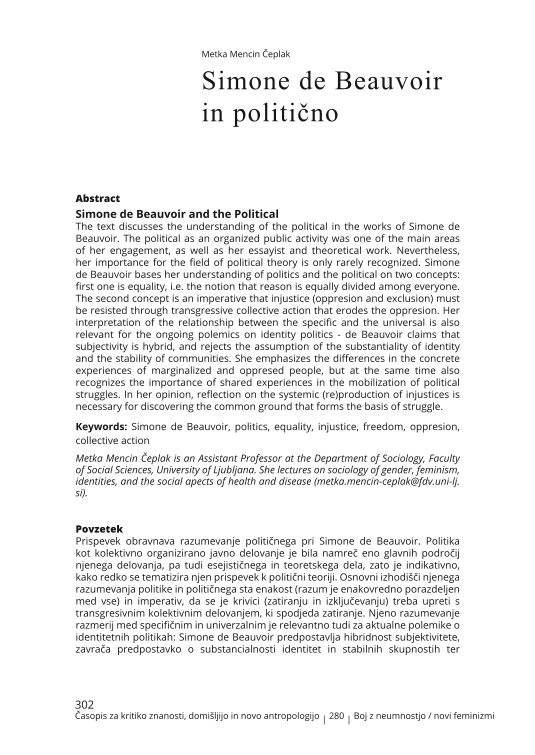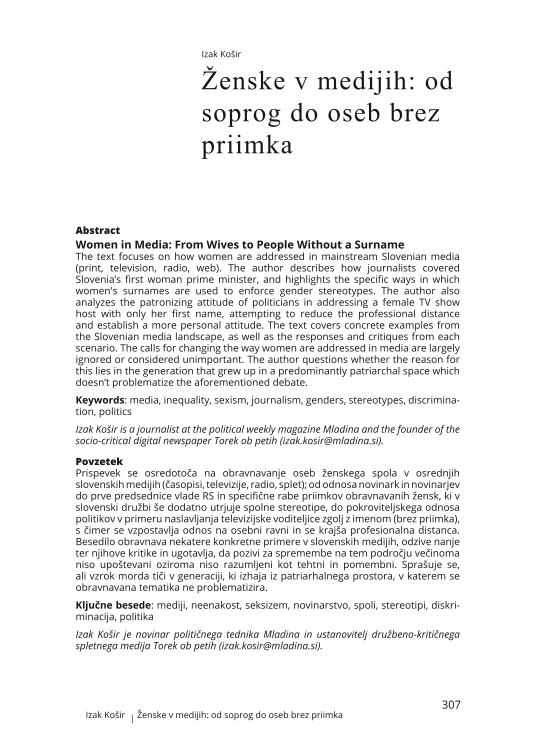V zgodovini politične misli zaseda prispodoba strahu vse prej kot zanemarljivo mesto, saj jo srečamo v nekaterih osrednjih tekstih tako klasične kot sodobne politične misli. Locus classicus nedvomno pripada uvodnemu stavku Marxovega Komunističnega manifesta, v katerem s prispodobo o »strahu komunizma« zaobjame takratni duh časa političnih sprememb (Marx, (2010 [1848]). V sodobni politični misli ni nič drugače. Prispodoba strahu se na primer pojavi v enem od »modernih klasikov«, in sicer v eseju Liberalizem strahu ameriške filozofinje Judith Shklar (1989) ter v knjigi The Multiculturalism of Fear Jacoba Levyja (2000).
Ever since the 1970s, the world has been confronted with the phenomenon of Islamist terrorism. In the 1990s, the radical Islamist organization AlQaeda perpetrated several destructive and primarily suicidal attacks on American targets. The climax of AlQaeda's terrorism was the September 11, 2001 attack, which was carried out on American soil. After the USled invasion of Iraq in 2003, even more destructive terrorist attacks were started being perpetrated in Iraq by the radical Islamist organization Islamic State. Between 2015 and 2017, the Islamic State carried out several attacks in Western Europe and the United States of America, with the majority of victims being civilians. In the West, the terrorism of AlQaeda and the Islamic State is primarily explained by discussing their irrational destructive nature or their expansionist motives. This should come as no surprise as the West has a long history of antiIslam discourse. However, one should explain Islamist terrorism by taking into account the historical background (the Crusades and the period of European colonialism), the specific grievances of the greater part of the world's Muslim population, and the effects of aggressive Western policies in the Muslim world. In addition, the SunniShia division within Islam must also be accounted for. To achieve this, one can enlist the help of the sociological (religiological) concepts of cultural defense, religious performance and cosmic war.
The paper deals with the phenomena of intolerance and radicalism from three perspectives. The first is the classification or typologization of such activities (Cross and Snow) by two criteria, namely the levels of social capital between the actors themselves and the level of perceived risks that threaten the actors from the outside. Such a classification has the advantage of simplicity, but suffers from limited reach. This can be expanded by a fourdimensional model (the “cage of radicalization”) that combines the cognitive, political, existential and temporal dimensions of the phenomenon. The third aspect of radicalization is structural violence. The most common reasons for this are social inequality, a confluence of social stratification with another type of stratification (for example ethnic or religious), stratification immobility, intolerance from above (the socalled “Jag syndrome”) and intolerance from below (authoritarian syndrome) – this last reason for structural violence is illustrated with empirical data for Slovenia in comparison with Europe as a whole. The data is worrying.
The concept of radicalization related to religion, which is used in official documents and affects the official discourse, contains the idea that the end point of radicalization is dangerous extremism or terrorism. Accordingly, radicalized individuals are viewed as posing a serious threat to society. When a radicalized individual is detected, the proposed course of action is to monitor them through state institutions in an attempt to prevent further radicalization or deradicalize them. This approach provides moral and often legal justification for the encroachment on certain rights and freedoms of individuals that the state labels as radical. The discussion usually revolves around the rights to privacy, freedom of speech, and citizenship. The author takes a different approach and instead discusses the issue of radicalization through the lens of the right of freedom of religion and belief. In democratic societies, this a crucial and basic freedom; in a certain sense, it is even unlimited as beliefs are impossible to control and should not be controlled. Nevertheless, the state can and should limit practices and acts that can be connected to certain beliefs, religious or otherwise. Given this context, the author presents and analyzes the case of Islamist extremist Anjem Choudary.
The interview with Quassim Cassam raises some of the neglected epistemological aspects associated with the process of radicalization (e.g. indoctrination) and its intricate relationship with violent extremism. In the main part of the interview, Prof. Cassam elaborates in detail on the three main obstacles in this area of scholarly research: (i) the lack of clarity about key concepts; (ii) the flawed assumptions about the nature of radicalisation, and (iii) the flawed assumptions about the nature of causation.
The immigrant crisis and the rise of right wing populism have offered a new framework for violent conflicts and even episodes of terrorism in the countries of the Northern Hemisphere. With this in mind, we must come back to the challenge of explaining cognitive radicalization (to use the term proposed by Q. Cassam). One line of answering the question is pointing to the setting of mutual antipathy that gives rise to the vicious circle of mutual strengthening and radicalization. The initial steps are dictated by the socioeconomic fears of the unprivileged classes of the host societies and the negative attitudes caused by the experience of Western interventions in the societies of wouldbe immigrants. The behavior of both sides is fueled by negative and mostly false stereotypes. Once the two groups are faced against each other, the vicious circle expands, deepens and gains strength, with the negative stances being articulated by leading conflictmongers on both sides. The understanding of this epistemic viciousness might offer some interesting explanations of this phenomenon. Cassam, who has developed a deep and original moderate epistemic particularism, is doubtful about the effectiveness of this approach; despite this, the article looks to explore the extent to which mutual knowledge between the two parties can contribute to the improvement of the situation. By learning more about each other and the new situation, we can open up possibilities for overcoming some of the most important cognitive causes of extremism and violence. Ameliorative epistemology should take this possibility seriously.
Gas, Shoot, Kill: The End of Humanity and the Universalism of the Double Language of Hatred Against Muslims and Jews
(
The article deals with hateful antirefugee comments made by Slovenian users on social media platforms and compares them to the antiSemitic discourse in contemporary Germany and the United Kingdom. It should be noted that the article does not treat these comments as being specific to the Slovenian environment in any way. The hatred, which can be universalized as the relationship between antisemitism and antirefugee xenophobia (or Islamophobia), contains a number of homogenous elements. The cultural, religious, economic and conspiratorial motives behind the hatred and fear of the Other were formed in a similar fashion when it comes to both the hatred of Jews, and especially after 2015, the hatred of refugees. If the former is distinguished by the characteristic contempt for Jews, the latter is dominated by antiMuslim and Islamophobic sentiments. However, the discursive features and metaphors are remarkably similar in both cases, and the expressions of hatred, racism, xenophobia and intolerance against refugees have transformed into open approvals of Hitler, fascism, Nazism, and the Third Reich, as well as a fascination with the horrific acts of the Holocaust, genocide, extermination, suffering, torture and killing. The paper attempts to show, at the level of concrete analysis, the similarities of the two public discourses and how Islamophobic discourse has adopted the linguistic apparatus developed by antisemitism, while also refreshing it and radicalizing it further. The analysis of the refugee (or the migrant) and the Jew in the language of hatred points to many analogies: just as we presumably needed an awakened leader (Führer) to deal with the Jews, we now need a new Hitler to deal with the refugees; the figure of the former was replaced by the figure of the latter. From this, we can conclude that Islamophobic discourse fundamentally overlaps the antisemitic discourse: the refugee today is occupying the position of a threatening Jew. The relatedness of both discourses contributes to the consolidation and normalization of Islamophobia in the public space as a form of new racism and thus provides rationalization for a belief system that unambiguously triggers sympathy for the Holocaust, genocide and killing, only this time based on Islamophobic prejudices against refugees.
Many researchers started investigating the characteristics of political violence due to the seriousness of its consequences. Unfortunately, the methodological approach to that investigation often lacks the high standards of scientific rigour. The article's authors briefly discuss the theoretical roots of the attempts of understanding political violence, with an emphasis on how these starting points are reflected in existing operationalizations. The authors also tackle the issues originating from the relation between an individual's attitudes and actual behaviour in the context of political violence, the psychometric characteristics of the available instruments, the importance of detecting specific forms of political violence, the tension between the desire to be truthful and the tendency towards giving socially acceptable answers, and the seriousness of the consequences that can arise from a reckless public presentation of results. The authors present cases from recent literature showing the significance of each of the potential risk factors. The article concludes by recognizing the importance of a multimethod approach to investigating political violence and the benefits of such an approach.
Despite September 11, 2001 becoming “Year One” of the “War on Terror” calendar era, the socalled security paradigm trapping the debate on radicalization and violent extremism is marked by a series of failed encounters and missed opportunities. This has been confirmed by a number of slogans, metaphors and other clichés that use “conventional wisdom” to hit the target, but somehow still miss the point. Radicalization and violent extremism are not exclusively a security phenomenon and therefore do not (exclusively) belong to the domain of the security and intelligence industry. At the same time, the discussion of the phenomenon of radicalization and violent extremism is also marked by a high degree of conceptual confusion over some of the fundamental concepts that are part of its gravitational orbit. This article raises some of the fundamental questions (and a series of adjacent problems) concerning the very notion of violent extremism, which remain largely overlooked in the scholarly discussions. A special emphasis is placed on the analysis of the conceptual and moral dimension of violent extremism (what violent extremism actually is and why it is problematic) and on the analysis of the relationship between the two basic concepts of this phrase, i.e. the concepts of violence and extremism.
Filozofijo je v 20. stoletju pretresla povsem nova usmeritev v mišljenju, v kateri je osrednja vloga pripadla profesorju filozofije Gillesu Deleuzu. Čas Deleuzovega poučevanja je bil čas francoske filozofije in njenega »momenta«, ki je po svoji veličini primerljiv z antično Grčijo in nemškim idealizmom (Badiou, 2012: lxi). Univerzalnost filozofije, prestreljena s časovno zamejeno zgodovino in specifično določeno geografijo mišljenja, je lahko tako postala konkretna univerzalnost (ibid.), ki je pri Deleuzu tesno povezana z »Nietzschejem v Franciji«. V teh okvirih je bila v ospredje postavljena nova in nevarna nasprotnica mišljenja: neumnost.
V zbirki predstavljamo primere iz doslej zbranega gradiva. Zbirko bi lahko dopolnjevali vsak dan, na njeni osnovi pa vsem, ki jih samoumevnost, neumnost in nizkotnost mišljenja motijo, tako kot Foucault položili v roke zemljevide, ki kažejo investicije oblastnih razmerij in možnosti odpora, ter pozvali k skupnemu projektu zbiranja in upiranja. Geslo razsvetljenstva je bilo Drzni si vedeti!; danes ga lahko razumemo kot spodbudo za spopad z neumnostjo kot nasprotnico mišljenja in znamenjem nizkotnosti, ki najeda razum ter je povezana z dominacijo in podrejanjem.
Filozofi so, kot poudarja Gilles Deleuze, neumnosti škodovali; temu je namenjeno tudi naše zbiranje, ki nagovarja k iskanju mesta, na katerem ne bomo več tako zelo podrejeni, ne na tak način, ne od njih, kot je zapisal Michel Foucault ob vprašanju Kaj je kritika? Nekateri primeri prihajajo iz vsakdanjika, drugi iz študijskih in strokovnih virov, tretji iz medijev in še od kod, vsem pa je skupno, da se v njih kažeta pretirana obeleženost in »obteženost« ženskega spola, kar je vredno izpostaviti in poskušati spremeniti (glej predhodno besedilo).
From Identity to Sexual Difference. Feminism, Psychoanalysis, and the Position of Enunciation
(
In its endeavours for gender equality and the pluralism of gender identities as the individual's selfdetermination, contemporary feminist thought largely views the sexual difference between man and woman as yet another essentialist binary opposition to be overcome or which has already been overcome. The article juxtaposes Simone de Beauvoir and her conceptualisation of woman in the Second Sex with Judith Butler and her critical analysis of the problem of gender identity in Gender Trouble. The author keys in on the importance of Freud's psychoanalysis in the conceptualisation of the sexual difference between man and woman as the paradigmatic difference, and woman as the paradigm of the Other as derived from Beauvoir, and indicates some limitations of the concept of gender identity. The author highlights the importance of the position of enunciation, as opposed to the contents of enunciation and the proliferation of identities and their namings which do not eliminate the fundamental problem of the asymmetry of sexual difference and the related “subversion of identity”, but, as she argues, only displace it. She raises the question of whether gender identity and sexual difference belong to the same field of critical thought, and whether advocating for the possibility of gender identity, even though the renewed conception of identity as being unstable, implies the exclusion of sexual difference and disregards the problem of the oppression of women and feminism as such.
The aim of the article is to conceptualize hysteria as a feminist attitude by analyzing a classic piece of world literature. The discussion focuses on whether Nora, the protagonist of Ibsen's play A Doll's House, is a feminist character, and whether she can be compared to the cases described in Freud and Breuer’s Studies on Hysteria and similar works. If hysteria can represent resistance when viewed through a feminist perspective, does the case of Nora also represent resistance against patriarchal norms and expectations? Ibsen published A Doll’s House in 1879 and the play was deemed highly controversial, primarily because of its conclusion. At the time, socalled “ibsenism” was considered synonymous with hysteria. The article presents Nora' s radical transformation from an object, or a doll in the dollhouse, into an autonomous person. At the end of the play, Nora commits the unthinkable act of rejecting the identity of a mother and a wife and, by extension, the associated patriarchal societal norms.At the core of discussion, which draws on feminist analyses of hysteria and its potential subversiveness, is Nora’s wild tarantula dance in which she uses her body to express her pain, similarly to Freud’s hysteric. The analysis relies on Catherine Clément’s “tarantula theory”, in which women dance the tarantula dance to cure an imaginary tarantula bite. This bite, which represents the “invisible powerful insect of patriarchal tradition and law”, is positioned in the context of discussions regarding the forms of feminist resistance that are relevant today.
The first part of the article presents the connection between Friedrich Nietzsche’s concept of perspectivism and Donna Haraway’s concepts of situated knowledges and partial perspective. Nietzsche’s perspectivism means placing oneself in a partial position, which cannot be reduced to relativism. Meanwhile, Haraway writes about taking specific partial positions, from which we can see and notice certain things; these are subjugated positions. Nietzsche and Haraway raise the question of how to “see differently”, but perspectivism also includes the issue of will and the concept of “wanting to see differently”. All perspectives aren’t equally good, which is why both authors emphasize the importance of differentiating between good and bad perspectives. However, neither are reducible to relativism. The problem of different perspectives and the position of the observer, which is characterized by Haraway as “learning to see” from a subjugated position, is not easily achievable and cannot be taken for granted. In the second part, we connect this problem to Benveniste’s linguistic analysis of the position of enunciation and its accompanying definition of subjectivity. In the final part of the article, the author taps the work of Roman Kuhar and Michel Foucault to situate this discourse in the broader context of what it means to speak in one’s own name as opposed to speaking for others, and how pronominal feminist politics can help us avoid the dilemma of choosing between a collective feminist “us” and a supposedly neutral and “nonsubjective” gaze. The author also addresses the problems brought on by romaticising the power that’s supposedly automatically derived from the accounts and confessions of personal experiences in feminism.
Stop the LGBT Revolution! - Go Ahead and Try! (Anti)Homophobic and (Anti)Patriarchal Graffiti of the Post-Socialist Transition
(
The article deals with political graffiti and street art addressing sensitive topics related to gender and sexuality in postsocialist Europe, and particularly in Slovenia. Its central research question is how the discourses of homophobia and patriarchalism are constructed and presented on the walls and what reactions and resistances they provoke. The themes of such graffiti usually appear in opposition pairs, i.e. pro et contra, with the most common themes being patriarchalism, feminism, questioning of sexual binarism, sexual and sexual denunciations (in the sense of discrediting various “others”), sexual selfidentification, (anti)homophobia, (anti)transphobia and direct politicization of the movement. The methods of graffiti and street art resistance to sexual and sexual discrimination are either spontaneous, in the form of sprays or templates by anonymous graffiti artists, or organized (actions within the scope of the Red Dawns festival, Slovenia; Decontamination project, Slovenia; Antifa Sisters, Slovenia; Silent protest, Russia; STAB school, Kyrgyzstan). The author concludes that the hegemonic struggle over gender and sexuality issues is also being fought on the walls of postsocialist cities, which until recently were primarily the domain of leftwing movements and individuals.
“Her Song Defied Even Death”: Towards the History of Female Sonic Artists in the Area of Former Yugoslavia
(
Since the 1990s, we’ve been observing attempts of introducing a feminist perspective in the fields of history of music, musicology, and the sociology of music. We can also see this process happening in Slovenia and exYugoslavia more broadly, but not yet in a systematic way. In these areas, the feminist perspective is also mostly excluded from the main scientific currents. Meanwhile, the general public has been building lists of female sonic artists; a quantitative approach with a certain feminist awareness. However, this approach appears to be inadequate, as it is exclusionary and looks for the object of its research in the conventional (dominant) interpretations of the term composer, i.e. precisely where exclusion has already been performed. Furthermore, we observe that the absence of women in the sonic arts isn’t a historical fact, but a process (of erasure). We thus call for a different methodological approach that entails a questioning of the main signifiers and meanings and their redefinition through the feminist discourse and lesbian theory, a scientific orientation towards the areas where compositional practice might not be expected, and finally a new historiography of sonorities which doesn’t merely rely on previous findings, but predominantly leverages new discoveries and their revolutionary potential.
The work involved in the upbringing of preschool children is not equally distributed between fathers and mothers. Preschool education is a special area of feminist critique, and there’s plenty of discussion regarding the feminization of kindergardens, which are the main institutional form of education for preschool children. The majority of kindergarden employees are women, the presence of men is very small or barely detectable. While there have been efforts to change this distribution, there are still many obstacles along the way, including the fear of sexual abuse. The text shortly describes a case from a Slovenian kindergarden where a male teacher was suspected of sexually abusing a threeyearold. Even though the suspicion turned out to be unfounded, the process itself had dire consequences for the teacher involved and indirectly affected the employment prospects of male kindergarden teachers.
The text discusses the understanding of the political in the works of Simone de Beauvoir. The political as an organized public activity was one of the main areas of her engagement, as well as her essayist and theoretical work. Nevertheless, her importance for the field of political theory is only rarely recognized. Simone de Beauvoir bases her understanding of politics and the political on two concepts: first one is equality, i.e. the notion that reason is equally divided among everyone. The second concept is an imperative that injustice (oppresion and exclusion) must be resisted through transgressive collective action that erodes the oppresion. Her interpretation of the relationship between the specific and the universal is also relevant for the ongoing polemics on identity politics de Beauvoir claims that subjectivity is hybrid, and rejects the assumption of the substantiality of identity and the stability of communities. She emphasizes the differences in the concrete experiences of marginalized and oppresed people, but at the same time also recognizes the importance of shared experiences in the mobilization of political struggles. In her opinion, reflection on the systemic (re)production of injustices is necessary for discovering the common ground that forms the basis of struggle.
The text focuses on how women are addressed in mainstream Slovenian media (print, television, radio, web). The author describes how journalists covered Slovenia’s first woman prime minister, and highlights the specific ways in which women's surnames are used to enforce gender stereotypes. The author also analyzes the patronizing attitude of politicians in addressing a female TV show host with only her first name, attempting to reduce the professional distance and establish a more personal attitude. The text covers concrete examples from the Slovenian media landscape, as well as the responses and critiques from each scenario. The calls for changing the way women are addressed in media are largely ignored or considered unimportant. The author questions whether the reason for this lies in the generation that grew up in a predominantly patriarchal space which doesn’t problematize the aforementioned debate.
Aljoša Pužar (2019): Odraščanje v Južni Koreji: feministične etnografije transgresije. Ljubljana: Založba ZRC.
Odraščanje v Južni Koreji: feministične etnografije transgresije je delo, v katerem se avtor osredotoča na obravnavanje tako imenovane liminalnosti, vmesnosti, ki spremlja »svet deklet, ki je tik pred tem, da se odpre za transgresijo« (str. 42). Delo – njegove nastavke in izpeljave – vodi bogat etnografski material, ki mu avtor daje razmeroma prosto pot: pripovedi deklet govorijo (čim bolj) same zase. Pričajo o kompleksnosti, tudi kaotičnosti konformnosti in transgresije; pričajo o njuni hipnosti, mimobežnosti, pa tudi nerazdružljivosti. Uvodna poglavja dela so bolj teoretskega značaja, v nadaljevanju pa avtor najprej postreže z izbranimi »filmskimi zgodovinami transgresije« (str. 67), nato pa še z izseki pripovedi oseb, ki so sodelovale v raziskavi. Te obravnavajo različne sklope praks vsakdanjega življenja, ki v grobem oscilirajo okoli telesnega in spolno zaznamovanega videza, seksualne objektifikacije ter (nenormativnih) seksualnih praks, vključno s »teleščkanjem«, ki sicer ni spolni odnos, je pa »otipljiva fizična interakcija« (str. 174). V izsekih pripovedi, ki jih avtor pospremi z minimalnimi posegi in intervencijami z interpretativnimi nastavki, tako lahko beremo o dekletih, ki vstopajo na trg delovne sile in na področja, ki terjajo in pogosto tudi izterjajo specifične prakse delanja spola; o pojavnosti (samo)lutkizacije oziroma lutkizirane ženskosti, ki v zameno za partikularne kozmetične in kirurške posege ter posege na ravni (manj ljubkega) upravljanja z (zdaj bolj ljubkim) telesom obljublja »nekaj več« od tega, kar je dekletom dano (v najslabšem primeru obljublja družbeno statičnost namesto družbenega nazadovanja v smislu marginaliziranja in izključevanja); o »zasebnih« telesih, ki – v primežu družbenospolne regulacije – to prav zares nikoli niso in ki vendarle iščejo, včasih pa tudi najdejo prostore in razpoke, ki jim omogočajo oddih, ali, kot bi to poimenovala S. Ahmed (2014: 169), prostore dihanja, ki so neredko locirani v virtualnem. Ta s svojim (širšim) diapazonom možnega omogoča, celo olajša (spolno zaznamovane) prakse, ki so v svoji fizični različici mestoma težje izvedljive, pa tudi ostreje sankcionirane. Spremljamo lahko tudi pripovedi o seksualnih praksah, ki potekajo v podtalju vsakdanjega življenja in se realizirajo skozi družbeno regulacijo, ki ji akterka – ravno zato, ker je sestavni del nje same – ne more (povsem) ubežati.





